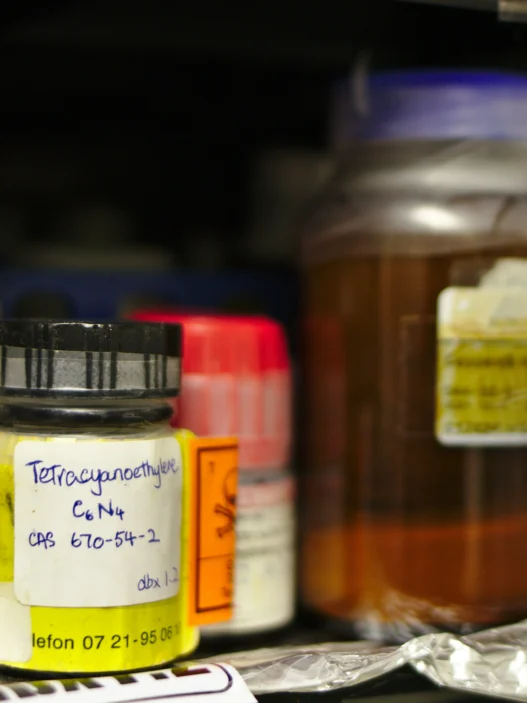Triethylene glycol monomethyl ether, also known as TriEGME, is a solvent commonly used in household and industrial products. It is particularly relevant in everyday life due to its use in the formulation of cleaning products, paints, and coatings. TriEGME serves as a versatile ingredient that helps to dissolve other substances effectively, making it essential in various applications such as household cleaners, automotive coatings, and industrial paints. Its ability to enhance the performance of these products makes it a key component in maintaining cleanliness and aesthetics in our daily lives.
Table of Contents:
Commercial Applications
Chemical & Physical Properties
Production & Procurement
Safety Considerations
Potential Research Directions
Related Compounds
 Commercial Applications
Commercial Applications
Triethylene glycol monomethyl ether, also known as TEGMME, finds its primary commercial and industrial applications as a solvent in various industries, including paint and coatings, printing, and electronics. Due to its high solvency power and low volatility, TEGMME is commonly used in cleaning products, degreasers, and as a component in synthetic lubricants.
In the pharmaceutical industry, Triethylene glycol monomethyl ether has found some utility as a solvent in drug formulations and as an excipient in topical medications due to its low toxicity and favorable solubility properties. However, its use in pharmaceuticals is limited compared to its industrial applications. TEGMME has also shown promise as a potential drug delivery vehicle, aiding in the transportation of certain drugs across biological barriers.
 Chemical & Physical Properties
Chemical & Physical Properties
Triethylene glycol monomethyl ether is a colorless liquid with a characteristic mild odor. It is commonly used as a solvent in various industries due to its favorable aroma and appearance.
The molar mass of Triethylene glycol monomethyl ether is approximately 178.24 g/mol, and its density is around 1.07 g/cm³. When compared to common food items, Triethylene glycol monomethyl ether has a higher molar mass and density than substances like sugar or salt.
The melting point of Triethylene glycol monomethyl ether is around -30°C, and its boiling point is approximately 258°C. In comparison to common food items, Triethylene glycol monomethyl ether has significantly higher melting and boiling points than water or cooking oil.
Triethylene glycol monomethyl ether is soluble in water and has a relatively low viscosity. Compared to common food items, it is more soluble in water than oils but less soluble than salt or sugar. Additionally, its viscosity falls between that of water and cooking oil.
 Production & Procurement
Production & Procurement
Triethylene glycol monomethyl ether, also known as Trieglyme, is commonly synthesized through the reaction of ethylene oxide with methanol in the presence of a catalyst. This process typically takes place in a reactor at elevated temperatures and pressures to facilitate the formation of the desired product.
Once Triethylene glycol monomethyl ether is produced, it can be procured from chemical manufacturers or distributors. It is often available in bulk quantities or pre-packaged containers for industrial use. Transportation of Trieglyme is typically carried out in sealed containers or tanks to prevent leakage and ensure safe handling during transit.
The procurement and transportation of Triethylene glycol monomethyl ether must adhere to strict safety regulations and guidelines due to its potential flammability and toxicity. Proper labeling, documentation, and handling procedures are essential to ensure the safe transfer of this chemical compound. It is important for personnel involved in the procurement and transportation of Trieglyme to be trained in handling hazardous materials to prevent accidents and ensure compliance with regulations.
 Safety Considerations
Safety Considerations
Safety considerations for Triethylene glycol monomethyl ether should include proper handling, storage, and disposal procedures to minimize exposure to this chemical compound. It is important to wear appropriate personal protective equipment such as gloves, goggles, and a lab coat when working with Triethylene glycol monomethyl ether. In case of skin contact, it is advised to wash the affected area immediately with soap and water. Also, it is essential to work in a well-ventilated area to prevent inhalation of vapors.
Hazard statements for Triethylene glycol monomethyl ether include being harmful if swallowed, causing severe skin burns and eye damage, and being harmful if inhaled. This chemical compound may cause an allergic skin reaction and may cause respiratory irritation. It is also flammable and may form explosive peroxides upon exposure to air and light. It is important to handle Triethylene glycol monomethyl ether with caution and adhere to safety guidelines to prevent any adverse health effects.
Precautionary statements for Triethylene glycol monomethyl ether include avoiding breathing vapor, fumes, or mist and wearing protective gloves, clothing, and eye protection. It is important to keep the chemical container tightly closed and stored in a well-ventilated place. In case of fire, it is recommended to use dry chemical, water spray, foam, or carbon dioxide for extinguishing. If swallowed, it is advised not to induce vomiting and seek immediate medical attention.田
 Potential Research Directions
Potential Research Directions
One potential research direction for Triethylene glycol monomethyl ether (TGME) could involve investigating its potential applications in organic synthesis. This could involve exploring its reactivity with various functional groups and its potential as a solvent for different types of reactions.
Another potential avenue for research on TGME could be its use in pharmaceutical formulations. Investigating its solubilizing properties and compatibility with different drug compounds could provide valuable insights for the development of new medications.
Furthermore, studying the toxicological properties of TGME and its potential environmental impact could be a crucial research direction. Understanding its interactions with biological systems and its long-term effects on ecosystems could be essential for ensuring its safe use in various industrial applications.
 Related Compounds
Related Compounds
One similar compound to Triethylene glycol monomethyl ether is Diethylene glycol monomethyl ether. This compound also contains three ethylene glycol units, but one of the oxygen atoms is positioned between the two carbon atoms, creating a slightly different molecular structure. Diethylene glycol monomethyl ether is commonly used as a solvent in various chemical processes and industrial applications.
Another similar compound to Triethylene glycol monomethyl ether is Ethylene glycol monomethyl ether. This compound contains only one ethylene glycol unit, with a methyl ether group attached to the oxygen atom. Ethylene glycol monomethyl ether is frequently utilized as a solvent in the production of paints, varnishes, and coatings due to its excellent solvency properties and low toxicity.
A closely related compound to Triethylene glycol monomethyl ether is Tetraethylene glycol monomethyl ether. This compound consists of four ethylene glycol units, with a methyl ether group attached to one of the oxygen atoms. Tetraethylene glycol monomethyl ether is commonly utilized as a solvent for various organic compounds and as a chemical intermediate in the synthesis of other compounds due to its solvency and reactivity.





